-
Posts
19,773 -
Joined
Content Type
Forums
Detector Prospector Home
Detector Database
Downloads
Posts posted by Steve Herschbach
-
-
3 hours ago, kiwijw said:
Steve, can you please tell us what coil on the Zed found which pieces of gold & at what depth? Thanks. I dont know if I can justify a 19 inch coil here in NZ.
I found it interesting that you used the GM 1000 as a scouting detector & if gold was found with it you would then go over the ground with the Zed. If you found no gold with the GM 1000 scouting, would you walk away & not wave the Zed over the same ground?
Hi JW,
If you go back to the original post all the nuggets were found with the GPZ with 14" coil except the ones separately pictured with a dime. Both the 1.2 gram and 1.3 gram nuggets found with the GPZ19 were about a foot deep. Best guess as I was not doing exact measurements. I don't think there would be any particular advantage for you given the size of the gold you normally find.
Make no mistake. Nearly all the time I spend metal detecting for gold nuggets I am swinging the GPZ 7000. It does not matter what I am doing usually, scouting, patch pounding, whatever, it is with GPZ 7000.
My comment about scouting was simply based on my recent reality. I saw a spot where some mining had taken place, and thought it might be trashy. So I grabbed the GM1000 and blasted over it. I discovered it was not as trashy as I thought, but main thing was I found that nugget also, which got me going then with the GPZ.
And another time I was driving a road exploring, and saw quartz on a hillside. I jumped out of the truck and took a spin up the hill and a little gully, where I found an old scrape. I did not find any gold, and that does NOT mean the spot has been written off. I will no doubt go back with the GPZ. But if I had found even a spec with the GM1000 I would have already been back. Now it is just a place on my list to revisit sometime. I would never write a place off just because I could not find gold with a GM1000, but my interest sure goes up if I do!
The bottom line is the GPZ is my main machine and so detectors like the GM1000 only get used for oddball jobs.
-
The Gold Monster 1000 is a VLF detector. If the ground is bad enough you need a PI the GM1000 does not change that. No new patent numbers attached!
The GM1000 does ground track. How it's ground tracking compares directly to the GMT in bad ground I do not know. It was tested in Australia by JP so his posts in that regard are more relevant than mine. Aussiau reported from Australia. The Gold Bug 2 does not have ground tracking.
The GM1000 also has auto-sensitivity. No other prospecting detector has this. It is possible that the ground tracking combined with the auto-sensitivity will allow a person to more easily operate on difficult ground than might be the case with other detectors. Notice I am not saying better, just easier.
Look guys, it's just a decent little detector, that's all. Setting up a Gold Bug Pro and a GM1000 for a grudge match might be interesting but that is the level we are playing at, not even close to SDC, GPX, or GPZ territory. I am not trying to sell anyone on this detector and no matter how much anyone tries I am not going to say anything different than what has already been said. Entry level, entry level, entry level.....
-
I wondered why you flagged 30 targets when I would have dug the first one. FYI most detectors will identify something like a shovel blade as non-ferrous.
My advice is forget the discrimination part, use auto sensitivity, and see if you can find metal with the detector. That is job one - just reliably find metal, any metal.
Or determine whether it is hot rocks that are signaling. If it is not hot rocks or metal but just the machine making random noise, try another location well away from possible power sources. If you can't get a handle on what is beeping and why, contact the person who took your money first, since you purchased their service and support. If that does not work, give the Minelab route a go.
-
No worries Mark. Like I said, do you have some question in particular?
Most people are looking for a "best" detector declaration. I on the other hand look at detectors like a socket set. I am the handle part that always is involved doing the real work. The detectors are just the sockets I swap out to get specific tasks accomplished. Some sockets get a lot of use, some very little. But I would not throw the one that gets very little use out because when I do need it, it is the only socket that will do the job. For somebody else with different tasks it might be their most used socket.
So basically you just asked me for my opinion on a 5/8" versus 11/16" socket.
They both do the same job in slightly different ways, and one excels where the other is weak. Which one works best depends on the job on hand and will change when the job changes.
-
Compares how Mark? I just talked about how the Gold Bug 2 and GM1000 compare in my last post and have gone over the subject in several other posts also. The Gold Bug 2 in general has the edge for the tiniest gold and in general is better suited for mild ground. The GM1000 has a slight edge (compared to the GB2) on larger gold in more varied ground conditions. What is it you are trying to find out specifically?
Yes, you do have to dig the gold nuggets you find when prospecting with a metal detector. Occasionally you will come across a "sun baker" sitting on the surface but that has only happened to me a handful of times over the years.
The larger the nugget the deeper you can detect them. Unfortunately most gold nuggets are small (smaller than coins) and so generally can't be found too deep. I have dug many tens of thousands of gold nuggets and most were only a few inches deep. 90% were less than a foot deep. Only coin size and larger nuggets are going no to be found more than a foot deep, and only multi-ounce nuggets can be found at depths exceeding two feet.
A few of the larger nuggets pictured had me digging holes about a foot deep with the GPZ 7000. Machines like the GM1000 and Gold Bug 2 excel at chasing tinier bits and that being the case many nuggets found using machines like them are quite small and quite shallow.
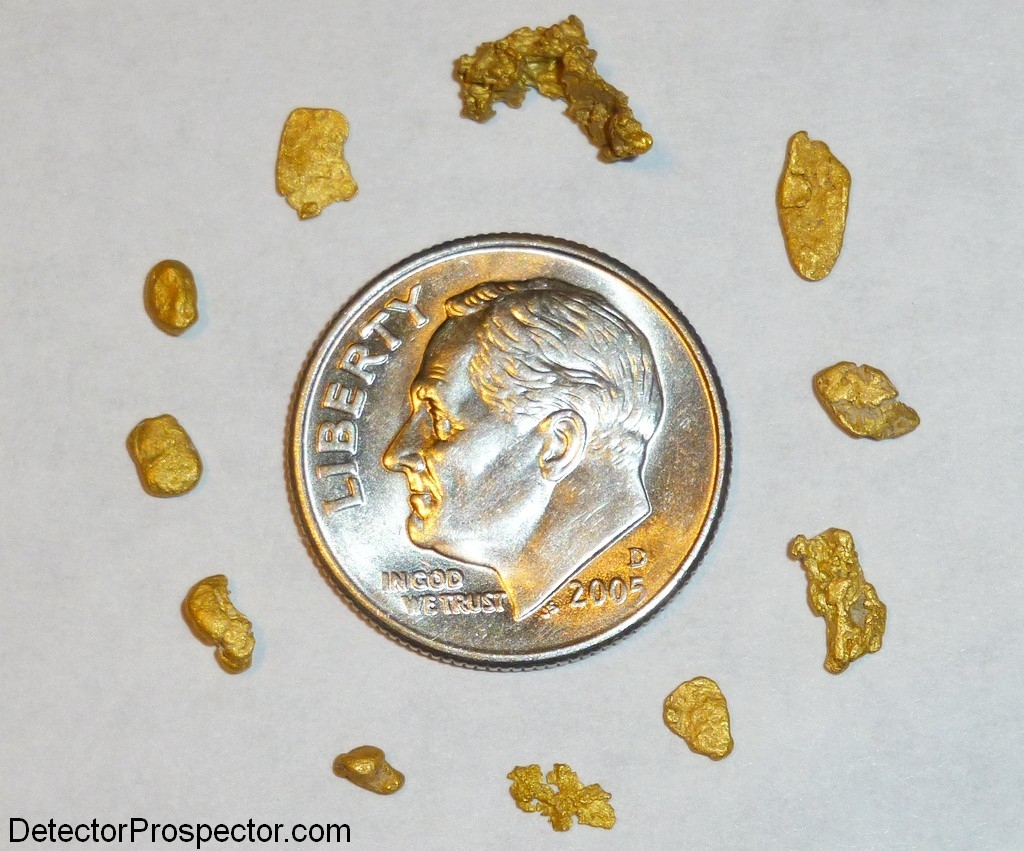 Eleven small nuggets found by Steve with GM1000 - Click for larger version. 14.9 grains total, largest 4.4 grains Smallest at bottom 0.6 grain and 0.3 grain
Eleven small nuggets found by Steve with GM1000 - Click for larger version. 14.9 grains total, largest 4.4 grains Smallest at bottom 0.6 grain and 0.3 grain
-
When you are like me and used to running machines hot and on the ragged edge it takes some getting used to going totally automatic. It goes back to me trying to identify what it is exactly that a detector does best and then use it for that.
Personally if I were trying to beat tidbits weighing less than a grain out of a small area I would probably use my Gold Bug 2 with 6" coil. It's a great little scrubber for finding the tiniest bits. But for general scouting the GB2 does not penetrate the ground very well and the manual tuning must be kept on top of also. The nice thing about running the GM1000 in auto sensitivity is you can just blast around and know if the ground gets better or worse the machine will adjust accordingly. When I am scouting I am not crawling along listening for whispers, I am as much just eyeballing the ground and seeing what I can see. This is where the boosted audio on top of silent operation works well. Just go for a spin and enjoy the quiet and views, but get over a target and "bang"!
For my ground a 14" elliptical would be sweet as again it is more about just quickly covering area more than anything. Great little recon unit for when I don't feel like getting all harnessed up with the GPZ.
-
A review of the new coil is disappointing Link deleted since Findmall update broke old links
-
The bumping is not an issue for me. It occurred rarely and only if I banged the coil hard. I might have to do the modification anyway though by placing a poly-carb piece on the bottom of the Nugget Finder skid plate. It seems very thin for the weight of the coil it is carrying and I do not expect it to be a long life item.
-
Big coils area tough call. I like them mainly for ground coverage but in this case the extra weight added to what is already a heavy detector makes it harder to get excited about putting the GPZ19 on the detector. People get all tied up in knots over the advertising and percentages which all strikes me as beside the point. I know the GPZ19 goes deeper than the GPZ14. Maybe it's only an inch, maybe more, maybe less, but I have no doubt when I put the GPZ19 on that I am getting that little extra I might need to make a find. It certainly is a nice feeling when you find a little patch like I did to be able to break out the big coil and give it another go. I always hate leaving a good spot thinking there might be something else lurking there just out of reach and the GPZ19 helps put that concern to rest.
-
It has certainly been a busy year for me so far, with not as much detecting time as I would like. Still, I have been getting out a little and thought it was time to share a few photos.
My first couple bits were found with the Minelab Gold Monster 1000 on some scouting runs. I am liking this detector as a grab and go unit for checking areas out quickly. I am not trying to hunt for max performance but instead looking to cover a lot of ground quickly to check things out. I have learned the GM1000 auto sensitivity actually suits me well for this. I just fire up the detector in all metal mode, full volume, and start with auto sensitivity set at Auto+1. Then I just start swinging. If noise intrudes (usually in salt areas) I will back down to Auto+0 (there are just two Auto settings available Auto and Auto+1).
Once the GM1000 gets out and about people will no doubt note the Auto settings are not the hottest. Which is why I like them. The GM1000 is a super hot machine already, so I am looking more for stability than anything else, and know it will pop hard on any small nuggets I get over. If I were pounding a patch hard I would use manual sensitivity and push it high, but that would introduce noise and require very careful hunting. For me however the GM1000 serves best as a light weight quick and dirty way to check new areas - just grab and go.
I posted previously about finding a nugget using Auto sensitivity which is where I learned how useful the setting is. Here are two more small nuggets located using Auto+1. Both nuggets banged hard, one at maybe an inch and the other at about three inches. I am not trying to promote or to push the use of this setting, I am simply reporting what I am doing and you can decide for yourself if it is useful for you.
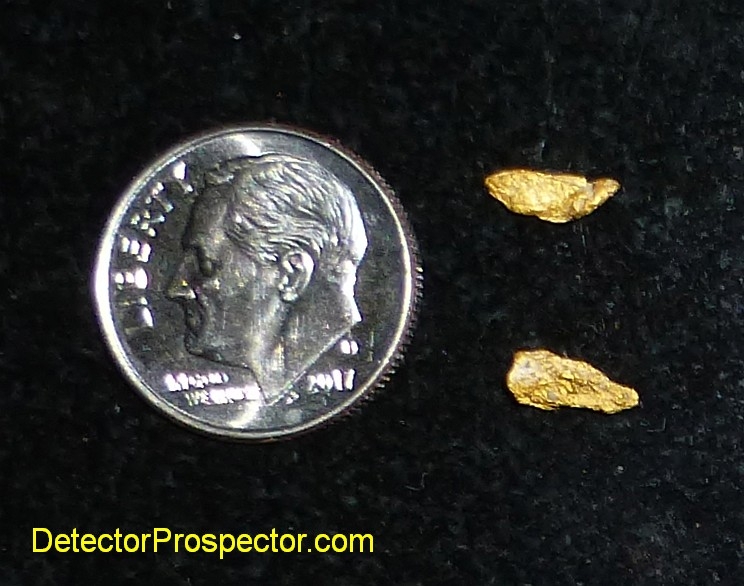
0.1 gram and 0.4 gram nuggets found with Minelab Gold Monster 1000 running in Auto+1 sensitivityI did finally get a GPZ 19 coil for my GPZ 7000 and it was time to give it a go. I tried one area I had hunted before in case a larger deeper nugget was lurking. My first lesson with the GPZ 19 was not how large and deep a nugget it can find but how small and shallow! The only thing I had missed and left to find was this less than 0.1 gram nugget. It was practically on the surface and so gave a small warble when it got close to the coil winding. I was surprised and impressed the coil can find gold this small.
The next location is one I scouted with the GM1000 and found the 0.4 gram nugget. The spot got my interest so I went back with the GPZ 7000 and 14" coil to hunt it. Turns out it was a nice little patch with some chunky gold! The ground was deep so I mounted up the GPZ19 and hunted it again. I did come up with one nugget I missed before, whether from sloppy detecting or just a little too deep I do not know. It was a little 1.2 grammer at around a foot down. I continued hunting outside my area and came up with another at 1.3 grams.
I had removed the Minelab skid plate that came with the coil and replaced it with the closed Nugget Finder cover. I like this cover for uneven ground as it does not get hung up of rocks and sticks as much, but it does rapidly collect a pile of debris!
The coil did false if banged on a rock and would require care in rocky ground, though I was running it as hot as ever so that contributes to it. I usually hunt grassy and sagebrush country and it does well here just gliding on the grass, though if the grass is deep it will ride up on it above the ground. Still, the larger size gave me this feeling that I had a little extra insurance in that regard and so I used it to hunt over low brush where it might reveal nuggets hidden when others went around the brush. False signals from banging a rock aside I do think the coil actually runs a bit smoother with my Insanely Hot settings. The GPZ19 is slightly too heavy for me for general use in hilly terrain and too large for a lot of the sagebrush areas. It is just the ticket however for covering large open terrain and that is where it will see the most use with me in the future, or for pounding old deep patches. The extra pound was not quite as bad as I was expecting and in flatter ground just my regular bungee setup sufficed. I did try out the Hipstick though and think it a better option for long hours with this coil.
Well, lots of info there I hope people can get some use out of. It's always nice to be out prospecting whether or not I find any gold - but gold does help! 24 grams or about 3/4 ounce with largest nugget 4.5 grams or just shy of three pennyweight.
-
Deleting my post instead of answering it definitely left a bad taste in my mouth. Here is what I posted that was deemed so bad it had to go:
"The latest rumor now for availability of the elliptical coil is mid-July. Would it kill XP to post a clear and definitive explanation of the when the coil will be available?"
For an outfit that designed a coil and update aimed specifically at prospectors XP is sure doing a lousy job of outreach to the prospecting community.

-
I made the mistake of asking on a thread on Findmall if it would kill XP to offer up any news about the delay on this coil (again) and when it might be released. Apparently I was not respectful enough or simply asking is wrong - either way the post was deleted. Pathetic.
-
It was my understanding your 6x10 coil is out of specification. If that is the case I would not be counting its performance as indicative of what a properly tuned coil might achieve.
-
The White's MX Sport is now one of the only "all terrain" metal detectors that comes standard with waterproof headphones. Most waterproof to 10 feet detectors do not come with the waterproof headphones required to make them truly submersible. The MX Sport is now ready for mask and snorkel work right out of the box.
-
Rob just posted at this here:
"Just a FYI, the Minelab Gold Monster 1000's have finally shipped. They should arrive here at our location early to mid next week. All orders paid in full will ship first, then all pre-orders. There are rumors that dealers didn't get all the unit they ordered on this first go around. "
-
On 6/5/2017 at 6:45 AM, Jin said:
At the Australian Airshow this year Codan had a stand, the Managing Director of Minelab said they were looking into fitting the sdc guts into the Monster box. Doesn't mean it will happen though but it would be great if it did.
I would rather have it in the Eureka Gold box for hip or chest mount.
-
-
All metal can be had in both motion and non-motion modes. Non-motion is pure and unfiltered and therefore is subject to drift. Very few detectors offer this mode.
Motion all metal modes add a filter, commonly referred to as SAT (Self Adjusting Threshold) or Autotune. This attempts to keep the threshold steady and if the coil is held motionless over the target the threshold fades away. Motion is required to keep the target beeping so we have "motion all metal". The higher the SAT setting, the more aggressive the filtering, the less depth. Nearly all VLF type nugget detectors employ this mode.
We can now add a discrimination filter. Items pass through the filter and are accepted or rejected. This filter requires more signal strength to deliver a result which is seen as lost depth.
Many low cost detectors only operate in discriminate mode. They can achieve a fake "all metal" mode by simply accepting all targets. However, the filter is still being applied and depth still lost.
VCO is not discrimination per se. A normal detector simply increases the volume with target strength. VCO increases volume and pitch. A loud squeal simply means a strong target.
Picture: Garrett Ace 250 features an "All Metal" mode that is a discriminate mode set to accept all targets.
-
Oops, I did not zero in on the "non-motion" part and so deleted my other post.
Fisher F75, Nokta Impact, White's V3i, XP Deus
The T2 and F75 are similar but are different detectors.
-
DetectorPro, LLC
1447 Route 44
Pleasant Valley, NY 12569Phone: (toll free) 800-367-1995 or 1-845-635-3488
Fax: 845-635-1838Email: info@detectorpro.com
Web Site: www.detectorpro.comDetectorPro headphones are warranted to be free of defects in materials and workmanship as long as they are owned by the original consumer purchaser. This warranty is not transferable, and is valid only if the registration card has been completed and mailed within 14 days of purchase.
This warranty gives you specific legal rights, and you may have other rights which vary from state to state.
During the first year DetectorPro will, at its option, repair or replace free of charge, including labor, any part(s) found to be defective under normal use excluding transportation charges. After one year from the date of purchase DetectorPro will replace defective parts at no charge except a nominal labor charge and transportation charges.
This warranty excludes headphones that have been abused, altered, or repaired by an unauthorized person. It also excludes wire breakage due to improper flexing. If you feel you have a warranty problem call DetectorPro to receive your return authorization number. This number must be displayed on the address label.
-
Good app, thanks for posting.
-
3 hours ago, johnedoe said:
I would still like to see a side by side with the White's GMT.
Me too!
-
If we are going to discuss reviews please link to them. I assume this is about argyle's post here.
There will always be those who want a detector to be something it is not.
Maybe if the words "entry level" are just repeated over and over....
Here are some better reviews http://golddetecting.4umer.net/t25227-gold-monster-1000
-
Lots of gold has been found with the 14 kHz White's MXT and 19 kHz Fisher Gold Bug Pro so the Impact frequencies are fine, just not in the same league as the over 30 kHz dedicated nugget detectors.
My big picture view is that the First Texas 19 kHz models like the Fisher Gold Bug set the benchmark in the mid-frequency class. The 18 kHz Garrett AT Gold, 18.75 kHz Minelab X-Terra 705 Gold, 19 kHz Nokta FORS Gold+, 17.8 kHz Tesoro Lobo ST, and now Nokta Impact all have performance close enough to the First Texas 19 kHz models that I am not going to debate over it. The XP Deus even at 18 kHz is in the running. The new high frequency coil may put it a notch above the others.
All these detectors offer similar all metal mode (nugget detecting) performance. I personally feel I can find gold as well with any of these as the others so when choosing one it is more about the other things they do than how they do on nuggets.
If you want a really good all around detector you will get just that but then have to live with the fact that people with specialty dedicated over 30 kHz nugget detectors will have an edge over you. Anything running that high however will not play well around salt water and are generally too hot on tiny trash for park detecting.
To sum up the Impact at 20 kHz certainly is in the running with the others. To flip it around it also has nothing in particular that sets it above the others as a nugget detector.


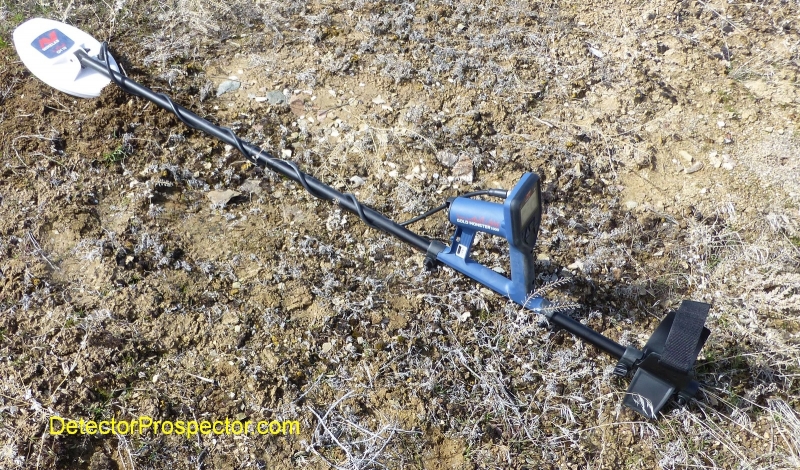
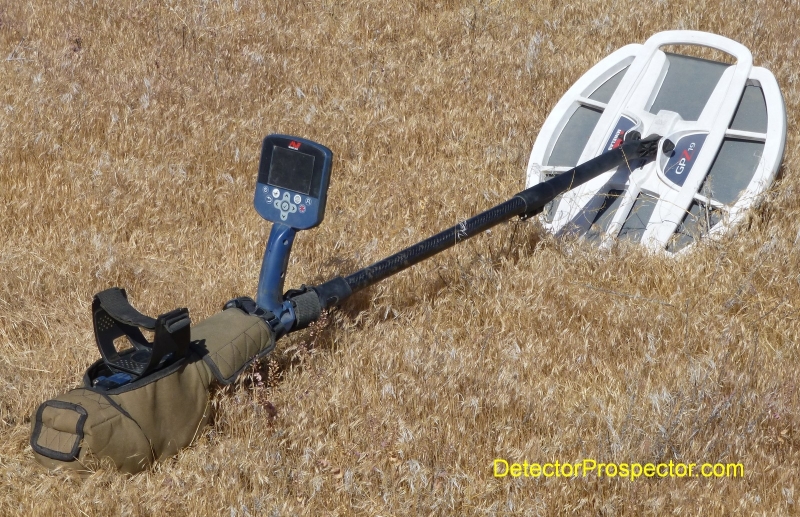
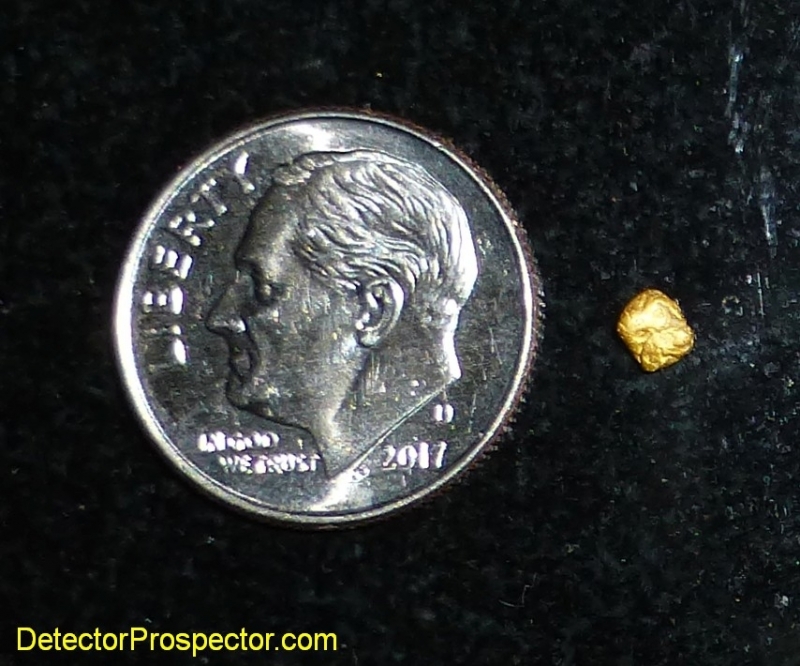
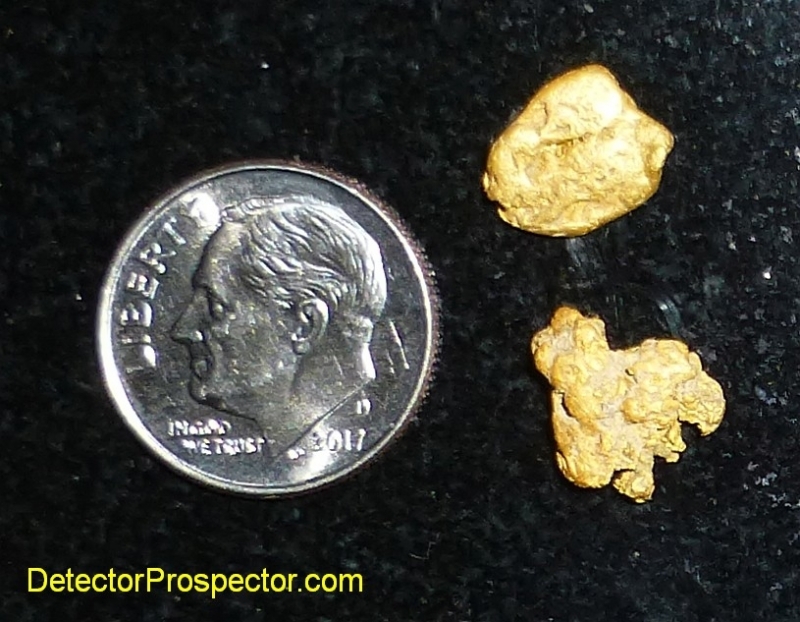
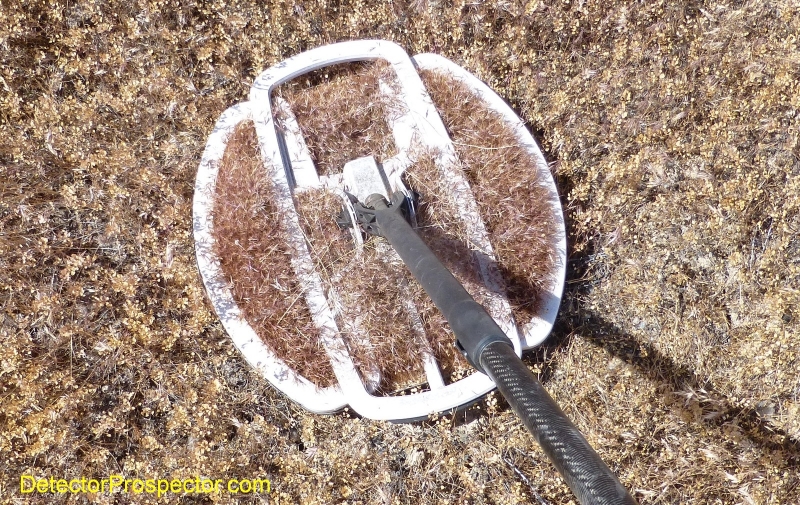
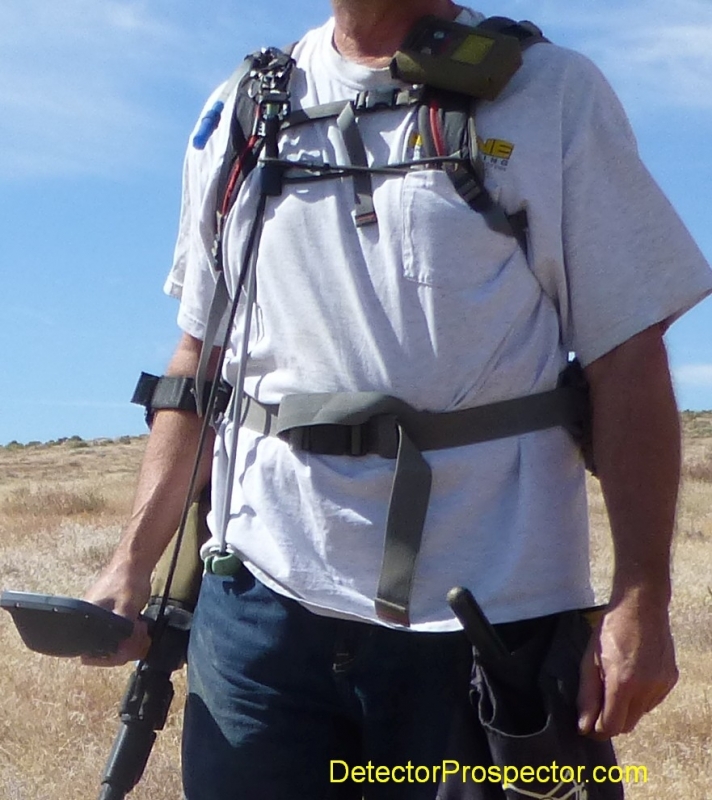
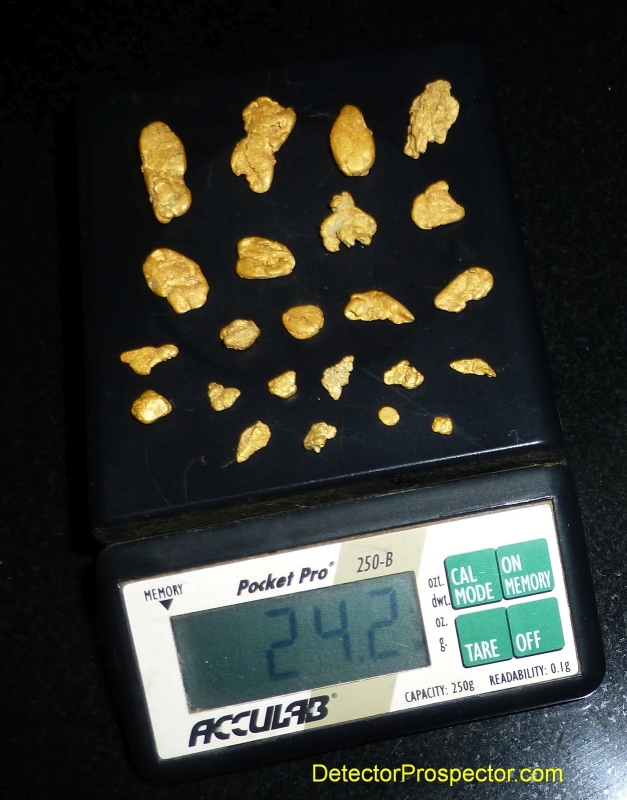
Sawtooth Knob Trip In May
in Detector Prospector Forum
Posted
Anybody have any luck? I was out of state at the time so could not make it.